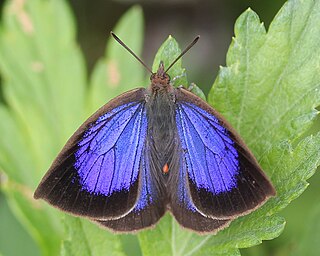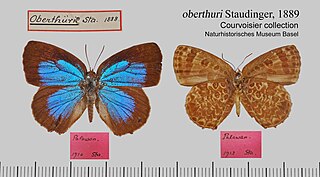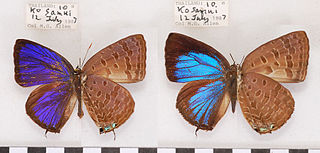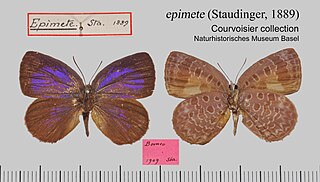
Arhopala is a very large genus of gossamer-winged butterflies (Lycaenidae). They are the type genus of the tribe Arhopalini. In the relatively wide circumscription used here, it contains over 200 species collectively known as oakblues. They occur from Japan throughout temperate to tropical Asia south and east of the Himalayas to Australia and the Solomon Islands of Melanesia. Like many of their relatives, their caterpillars are attended and protected by ants (myrmecophily). Sexual dichromatism is often prominent in adult oakblues.

Arhopala agelastus is a species of butterfly belong to the lycaenid family described by William Chapman Hewitson in 1862. It is found in Southeast Asia

Arhopala alaconia is a species of butterfly belonging to the lycaenid family described by William Chapman Hewitson in 1869. It is found in Southeast Asia.

Arhopala aida or white-stained oakblue, is a species of butterfly belonging to the lycaenid family described by Lionel de Nicéville in 1889. It is found in Southeast Asia . The upper surface of the male is lilac the black marginal band on both wings above equally broad. The under surface is brown with a distinct violet gloss;forewing with a light hindmarginal area. The female is above bluer, lighter than the male, and has a much broader black margin. aida differs from Ahropalus myrtale in its darker and more violet-blue and its broad outer margins ; the undersides are, however, very much alike.

Arhopala ammonides is a species of butterfly belonging to the lycaenid family described by William Doherty in 1891. It is found in Southeast Asia.

Arhopala athada, the vinous oakblue is a species of butterfly belonging to the lycaenid family described by Otto Staudinger in 1889. It is found in Southeast Asia - Singapore, Peninsular Malaya, Sumatra, Borneo, Bangka, Bawean, Assam, Burma, Mergui, Thailand and the Philippines.

Arhopala atosia is a species of butterfly belonging to the lycaenid family described by William Chapman Hewitson in 1869. It is found in Southeast Asia - Borneo, Sumatra, Bangka, Pulau Laut, Thailand, Indochina, Peninsular Malaya, Singapore, Burma, Langkawi, Mergui and Palawan.

Arhopala cleander is a species of butterfly belonging to the lycaenid family. It was described by Cajetan Felder in 1860. It is found in Southeast Asia.

Arhopala corinda is a species of butterfly belonging to the lycaenid family described by William Chapman Hewitson in 1869. It is found in Southeast Asia.

Arhopala epimete, the violetdisc oakblue, is a species of butterfly belonging to the lycaenid family described by Otto Staudinger in 1889. It is found in Southeast Asia.

Arhopala hellenore, Doherty's green oakblue, is a species of butterfly belonging to the lycaenid family described by William Doherty in 1889. It is found in Southeast Asia - Assam, Manipur, Burma, Mergui, Thailand, Indo China, Hainan Sumatra, Peninsular Malaya.

Arhopala muta is a species of butterfly belonging to the lycaenid family described by William Chapman Hewitson in 1862. It is found in Southeast Asia

Arhopala pseudomuta, Raffles's oakblue, is a species of butterfly belonging to the lycaenid family. It was described by Otto Staudinger in 1889. It is found in Southeast Asia - Peninsular Malaya, Singapore pseudomuta),Langkawi, Mergui, Burma, Thailand ,Sumatra, Borneo

Arhopala similis is a species of butterfly belonging to the lycaenid family described by Hamilton Herbert Druce in 1895. It is found in Southeast Asia . In this species, contrary to Arhopala catori, all the 4 spots in the costal area of the hindwing beneath are distinctly developed and in distinct light rings. In the forewing the postmedian transverse band is entirely absent, whilst in the hindwing it is broken up into hardly contiguous rings. Above the male is still more broadly margined with black than A. catori, particularly in the apex; the female is very similar to it, lighter blue.

Arhopala zambra, the Zambra oakblue, is a species of butterfly belonging to the lycaenid family described by Charles Swinhoe in 1911. It is found in Southeast Asia.

Arhopala paraganesa, the dusky bushblue, is a butterfly in the family Lycaenidae. It was described by Lionel de Nicéville in 1882. It is found in the Indomalayan realm.

Arhopala khamti, Doherty's dull oakblue, is a butterfly in the family Lycaenidae. It was described by William Doherty in 1891. It is found in the Indomalayan realm.

Arhopala moolaiana or pale yellow oakblue, is a butterfly in the family Lycaenidae. It was described by Frederic Moore in 1879. It is found in the Indomalayan realm.

Arhopala ariel is a butterfly in the family Lycaenidae. It was described by William Doherty in 1891. It is found in the Indomalayan realm.

Arhopala selta or reddish-brown oakblue, is a butterfly in the family Lycaenidae. It was described by William Chapman Hewitson in 1869. It is found in the Indomalayan realm.




















